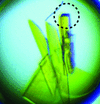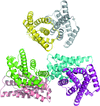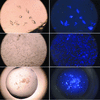issue contents
May 2018 issue

Cover illustration: Structure of the tandem PX-PH domains of Bem3 from Saccharomyces cerevisiae (Ali et al., p. 315). The structure shows that these putative lipid-binding domains adopt a relative orientation that enables them to simultaneously bind to a membrane.
research communications
The crystal structure of mouse BPIFA1 was solved at 2.5 Å resolution and compared with those of structural homologs.
PDB reference: Mus musculus BPIFA1, 6baq
Open  access
access
 access
accessTrehalose is used in the cryoprotection of glyceraldehyde-3-phosphate dehydrogenase (GAPDH) crystals and induces conformational changes in GAPDH from E. coli. The conformational changes were independent of the duration of cryoprotectant soaking for up to 10 min.
PDB reference: glyceraldehyde-3-phosphate dehydrogenase, 5za0
Siderophore-interacting proteins (SIPs) can reduce ferric iron to ferrous iron and cause iron to be released from the ferric siderophore complex. The SIP from Vibrio anguillarum 775 has been expressed, purified and crystallized. The crystal diffracted to 1.113 Å resolution, which is the highest resolution so far observed for a member of the SIP family.
New crystal forms of human CK2α2 were discovered and one showed improved crystallographic resolution to a maximum of 1.89 Å.
The recombinant production and crystal structure of chorismate mutase from Burkholderi thailandensis, which is a proxy for more virulent Burkholderia species, are presented. The enzyme shares conserved binding-cavity residues with other chorismate mutases, including those with which it has no appreciable sequence identity.
PDB reference: chorismate mutase from Burkholderia thailandensis, 6cnz
In situ specific proteolytic removal of a His tag by thrombin improves the morphology and diffraction quality of crystals of human aldo-keto reductase 1C3.
Improved protein-crystal identification by using 2,2,2-trichloroethanol as a fluorescence enhancer
Protein-crystal labelling with 2,2,2-trichloroethanol for more sensitive detection using UV light is described.
Open  access
access
 access
accessThe structure of the putative membrane-binding tandem PX-PH domain module of the yeast protein Bem3 is reported.
PDB reference: tandem PX-PH domains of Bem3 from S. cerevisiae, 6fsf
The CD163 long-range scavenger receptor cysteine-rich (SRCR) repeat was prepared in a Drosophila system and was crystallized using 20% PEG 4000, 0.15 M potassium sodium tartrate tetrahydrate pH 8.5. X-ray crystallographic characterization of this long-range SRCR repeat will provide structural and functional information for the scavenger receptor superfamily.


 journal menu
journal menu




















![[publBio]](/logos/publbio.gif)





